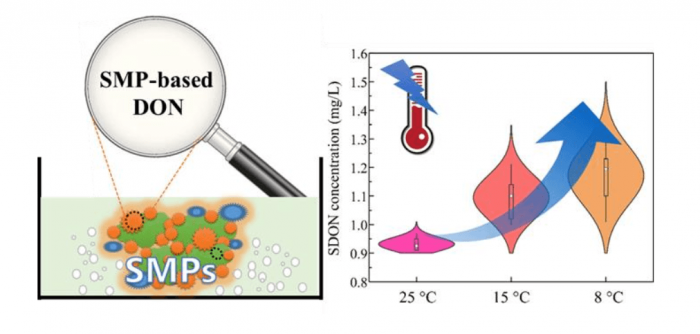
Traditionally, activated sludge has been the most commonly used biological process for municipal wastewater treatment. Soluble microbial products (SMPs) formed by microorganisms constitute a wide range of residual organic matter in biological wastewater treatment systems. Their presence is related to the removal performance of treatment systems and safe wastewater reuse. Among a variety of process parameters, temperature shows the most significant effect on SMP formation in activated sludge systems.
Most of the previous studies focused on the characterization of SMP-based dissolved organic carbon (SDOC) at different temperatures, and there are few reports on SMP-based dissolved organic nitrogen (SDON). Additionally, some nitrogenous organics have been identified as important parts of SMPs. Moreover, DON in wastewater is responsible for membrane fouling, leads to cultural eutrophication, and serves as a precursor to several disinfection byproducts. Accordingly, the need for a better understanding of the effect of temperature on SMPs characterization in an activated sludge system with special emphasis on SDON has become increasingly apparent.
Recently, a team of researchers led by Professor Hongqiang Ren from the State Key Laboratory of Pollution Control and Resource Reuse at Nanjing University evaluated the effect of different temperatures (8 °C, 15 °C, and 25 °C) on the chemical characterization of SDON in an activated sludge system. It emphasized the importance of SDON control during biological treatment processes at a low temperature with the purpose of reducing the potential effects of SMPs induced to the aquatic environment.

Figure courtesy Haidong Hu
Results showed that effluent SDON concentration ranged from 0.91 mg/L to 1.30 mg/L, and the low-temperature conditions (8 °C and 15 °C) resulted in the increase of SDON concentration in the activated sludge system. Fluorescence excitation-emission matrices coupled with parallel factor analysis (EEM-PARAFAC) and Fourier-transform ion cyclotron resonance mass spectrometry (FTICR-MS) were used to analyze the fluorescent components and molecular characteristics of SDON at different temperatures.
The results showed that the production of SDON at 8 °C and 15 °C exhibited more labile than that at 25 °C. This was also confirmed by the algal bioassay experiment. The SDON bioavailability at 25 °C, 15 °C, and 8 °C were 55.3 ± 4.1%, 61.5 ± 6.6%, and 65.8 ± 3.0%, respectively, indicating that SDON produced at low temperatures is more bioavailable and more susceptible to promote microorganism growth. Interestingly, the principal component analysis (PCA) results showed that the chemical characterization of SDON was different from SDOC at different temperatures. In these cases, the mere measurement of the DOC is not sufficient for understanding the effect of temperature on SMP production in activated sludge systems.
Overall, this study focused on the effect of temperature on SMPs characterization in an activated sludge system with special emphasis on SDON. The results of this study provided an important theoretical basis for SDON control during biological processes at a low temperature, and it is of practical significance to improve the water quality of municipal wastewater treatment plants. The work is currently published in the research journal Water Research.









